Every day, your business generates data — tons of it. It comes from all directions: CRMs, ERPs, marketing platforms, and support tools. Each one plays its role, but together, they often create a mess. Systems don’t talk. Data gets stuck in silos. Teams second-guess the numbers. Momentum slows.
That fragmentation doesn’t just cause headaches. It holds you back. You miss insights, stall decisions, and watch opportunities slip.
Data integration changes that. A robust data integration system brings everything together — clean, connected, and usable. Integration fuels smarter decisions, powers real-time visibility, and opens the door to AI and predictive analytics.
This article delves into what data integration truly is, why its importance is escalating in today’s market, and how your business can approach data management strategy to unlock its full potential. Here, we will provide a high-level data integration overview and explain key data integration concepts.
What Is Data Integration: A Business-Friendly Definition
At its core, data integration is the strategic practice of combining data from multiple, diverse sources into a unified, accessible, and usable format. Think of it as building intelligent bridges between all your organizational data, ensuring that information flows freely and consistently.
Dmytro Tymofiev
Delivery Manager at SPD Technology
Data integration is the backbone of a connected business — it’s how we turn scattered data into actionable intelligence. And why is data integration important? Because without it, you’re making decisions in the dark, with pieces of the puzzle missing.
Real integration is deeper. It means cleaning, reshaping, and aligning data so it’s actually useful. When it lands where it needs to be, it should be ready to go: accurate, consistent, and immediately meaningful. You’re not building a warehouse. You’re building a system that makes sense.
Let’s clear something up. Data integration isn’t just syncing two tools or tossing raw data into a giant bucket. That’s not how you get value.
Ready to transform your data into a strategic asset for competitive advantage?
Read our ultimate guide on enterprise data management.
The Rising Importance of Data Integration in 2025
Data’s coming in faster than ever and from more places than you can count. CRMs, ERPs, cloud apps, customer tools — it’s a constant stream. That kind of volume, paired with pressure to move quickly and stay competitive, changes the game.
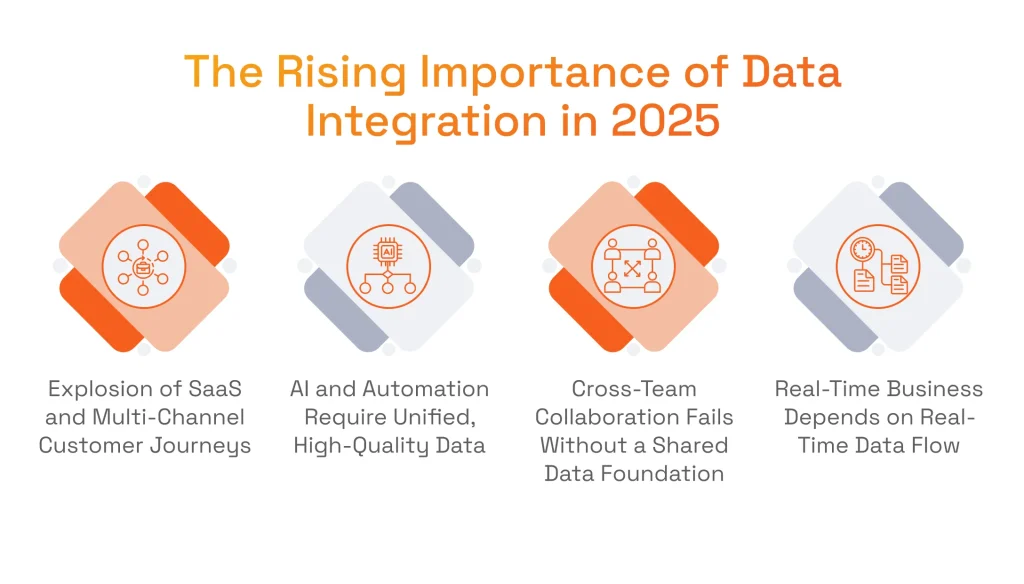
Organizations increasingly seek the advantages of strategic technology consulting to guide these data-driven transformations. At this point, strong data integration isn’t a nice-to-have. It’s the difference between keeping up and falling behind. Here are more reasons why:
The data integration market is expected to reach $26 billion by 2029, growing at a compound annual growth rate of 14.0%. As we see, the necessity of this strategic practice is growing exponentially, driven by Big Data and its business impact. Another major factor is the emphasis on improving security through data integration, which enables organizations to safeguard sensitive information with consistent access control and auditability across all systems.
- Explosion of SaaS and multi-channel customer journeys. Businesses now rely on an ever-increasing number of Software-as-a-Service (SaaS) applications. Customer interactions span more channels than ever — web, mobile, social, in-store, and more. Without integration, understanding the full customer journey becomes extremely difficult.
- AI and automation require unified, high-quality data. AI models don’t magically fix bad data. If what you feed them is scattered, messy, or full of gaps, don’t be surprised when the results fall flat. Inaccurate predictions, skewed insights, missed opportunities — they all start with poor inputs. Data integration and analytics go hand in hand, ensuring that your AI systems generate value from well-prepared datasets.
- Cross-team collaboration fails without a shared data foundation. When sales, marketing, finance, and operations teams operate with their versions of “the truth,” collaboration breaks down. Integration provides the standard data foundation necessary for synchronized efforts, shared key performance indicators (KPIs), and truly aligned business objectives.
- Real-time business depends on real-time data flow. Nowadays, market shifts and customer demands can change in an instant, so businesses need real-time insights to respond quickly. This demands real-time data integration capabilities to ensure that dashboards, reports, and operational systems always reflect the most current information.
Key Business Benefits of Data Integration & Costs of Ignoring It
Let’s explore the key benefits that highlight the importance of data integration and the measurable impact it delivers to modern enterprises. The fundamental question for any business considering data integration solutions isn’t merely “What is data integration?” but rather, “What concrete advantages will it deliver to my organization?” It all comes down to impact: on how you operate, how fast you move, and how well you perform.
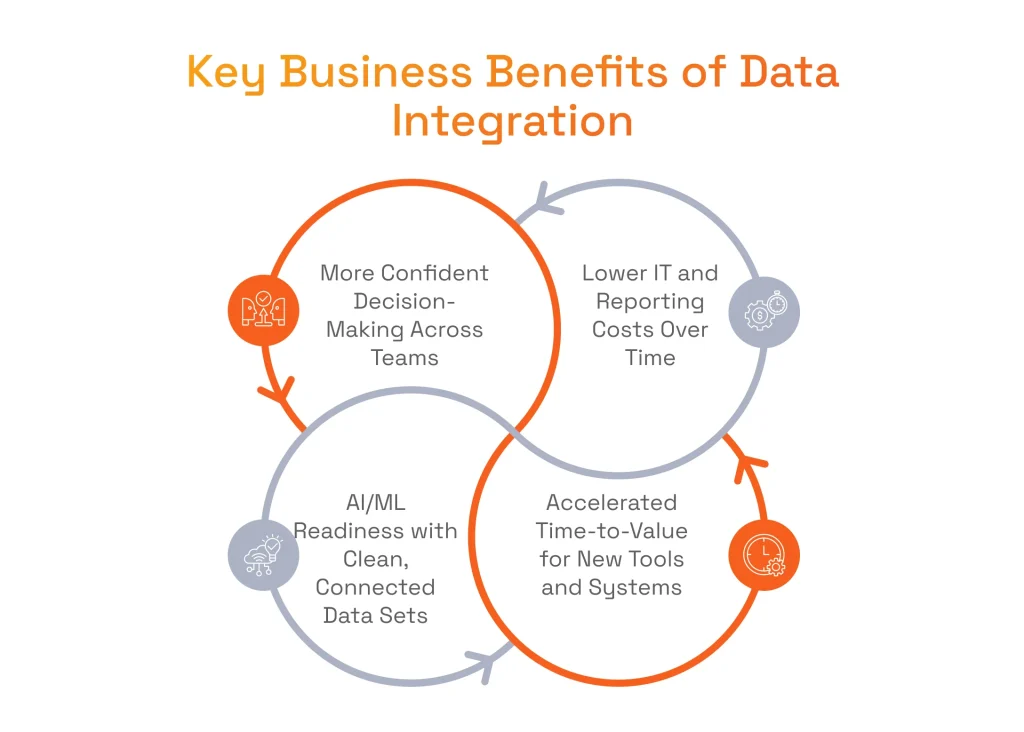
When data integration is done right, it doesn’t just tidy things up. It drives revenue, cuts waste, and sharpens your ability to adapt.
The tangible benefits from a well-executed data integration strategy directly bolster both your top-line revenue growth and bottom-line profitability. That’s how businesses grow smarter, faster, and stronger than the rest.
#1. Faster, More Confident Decision-Making Across Teams
Data integration empowers business leaders at all levels to make well-informed decisions with greater speed and increased certainty by establishing a consolidated and coherent perspective on your core business functions, encompassing operations, customer interactions, and financial status.
The endless back-and-forth over conflicting reports. Hours wasted patching together spreadsheets from different systems. That used to be the norm.
Now, teams can work from a single source of truth. Everyone sees the same numbers and KPIs simultaneously. No confusion, no second-guessing, just faster decisions and tighter execution.
#2. Lower IT and Reporting Costs Over Time
Yes, setting up a solid data integration solution takes effort upfront. But once it’s in place, the savings speak for themselves.
No more custom scripts just to move data from one place to another. No more manual cleanup or last-minute fire drills before a big presentation. And no more paying your top talent to fix what an intelligent system could automate. So, if you’re still living in spreadsheets, you’re spending more than you think.
This shift in data management strategy translates directly into substantial and recurring savings in IT personnel resources, reduces the operational overhead associated with maintaining complex and disconnected systems, and minimizes the costs associated with generating and distributing inconsistent reports.
#3. AI/ML Readiness with Clean, Connected Data Sets
AI and machine learning aren’t just buzzwords anymore. They’re fast becoming the baseline for staying competitive, but they don’t work in a vacuum. These technologies need a solid data foundation to thrive. That’s where data integration comes in.
When your data is connected, cleaned, and housed in one place, you unlock great speed. Analysts spend less time wrangling data and more time uncovering insights. Predictions get sharper. Automation becomes possible and powerful.
The real magic of AI starts with the groundwork. Without high-quality, integrated data, even the smartest algorithms are running blind. Integration isn’t a nice-to-have. It’s the core of the broader data strategy framework.
#4. Accelerated Time-To-Value for New Tools and Systems
As businesses grow and adapt to changing market dynamics, the need to adopt new software applications, upgrade existing systems, or expand their digital ecosystem is inevitable. In a fragmented data environment, these transitions often become complex and protracted undertakings.
Data integration fundamentally transforms this experience. When your core business data is already integrated and well-structured, new tools and systems can seamlessly tap into this existing data foundation. Thus, you significantly reduce deployment timelines, minimize the risks associated with data migration, and accelerate the realization of a return on investment (ROI) from these new technological adoptions.
This capability is especially impactful when paired with a well-defined data strategy roadmap, ensuring your organization’s data architecture evolves in lockstep with your digital initiatives.
The True Cost of Ignoring the Need for Data Integration
While the data integration benefits are compelling, the consequences of inaction are equally, if not more, impactful. Failing to invest in data integration technology hinders overall data integration progress, making future digital transformations more challenging and costly.
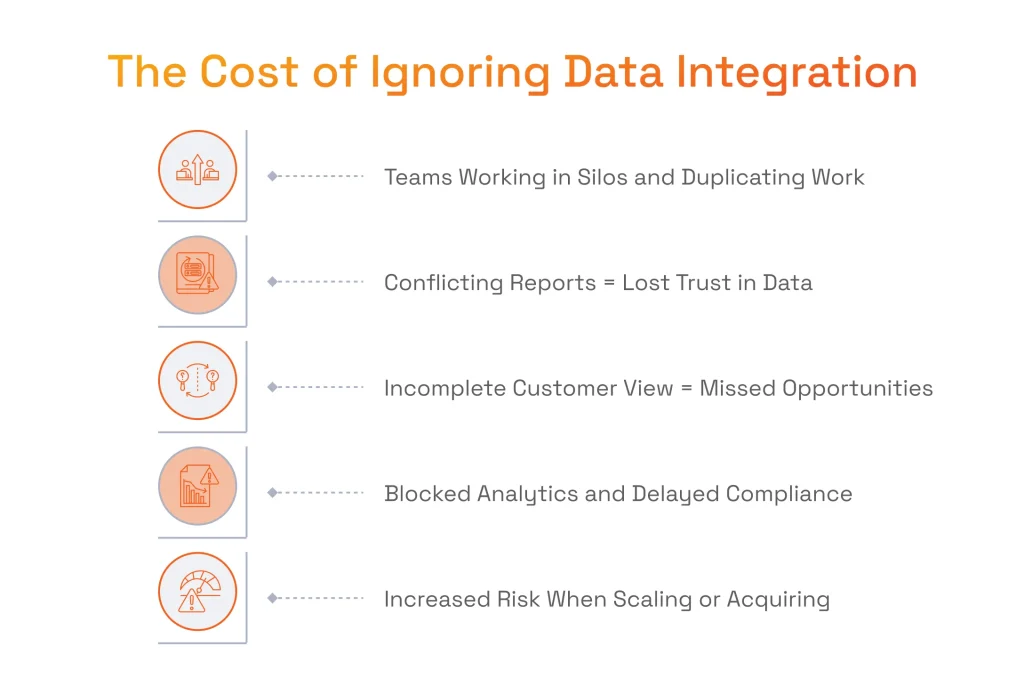
Departments operating without a shared data view often function in silos. This siloed approach results in redundant efforts and wasted resources, as each department independently creates its own datasets. Dataversity’s 2024 survey reveals that 68% of respondents cite data silos as their top concern, representing a 7% increase from the previous year.
Consequently, conflicting information arises, such as when sales reports contradict finance reports or marketing ROI remains unclear due to discrepancies across different tools. The lack of reliable data can lead to paralysis with decisions and analysis based on intuition rather than factual evidence.
Furthermore, an incomplete customer view emerges when customer interactions are dispersed across CRM, support tickets, and marketing platforms. This fragmentation hinders a comprehensive understanding of the customer. As a result, businesses miss opportunities for personalized experiences, upsells, and proactive customer service.
The fragmented data landscape also significantly impedes the ability to conduct analytics and meet regulatory compliance deadlines. The challenge of integrating disparate systems becomes increasingly difficult and risky as a business expands or incorporates new entities, especially when a fundamental data management strategy is not in place. Such setbacks reinforce the pressing need for data integration to build resilience and unlock scalable growth.
How Does Data Integration Work
Understanding the ‘how’ of data integration is crucial for appreciating its complexity, the challenges of data integration, and the expertise required for successful implementation. While the underlying technical processes can be intricate, the strategic goal remains simple: to empower your business with reliable, up-to-date, and connected data.
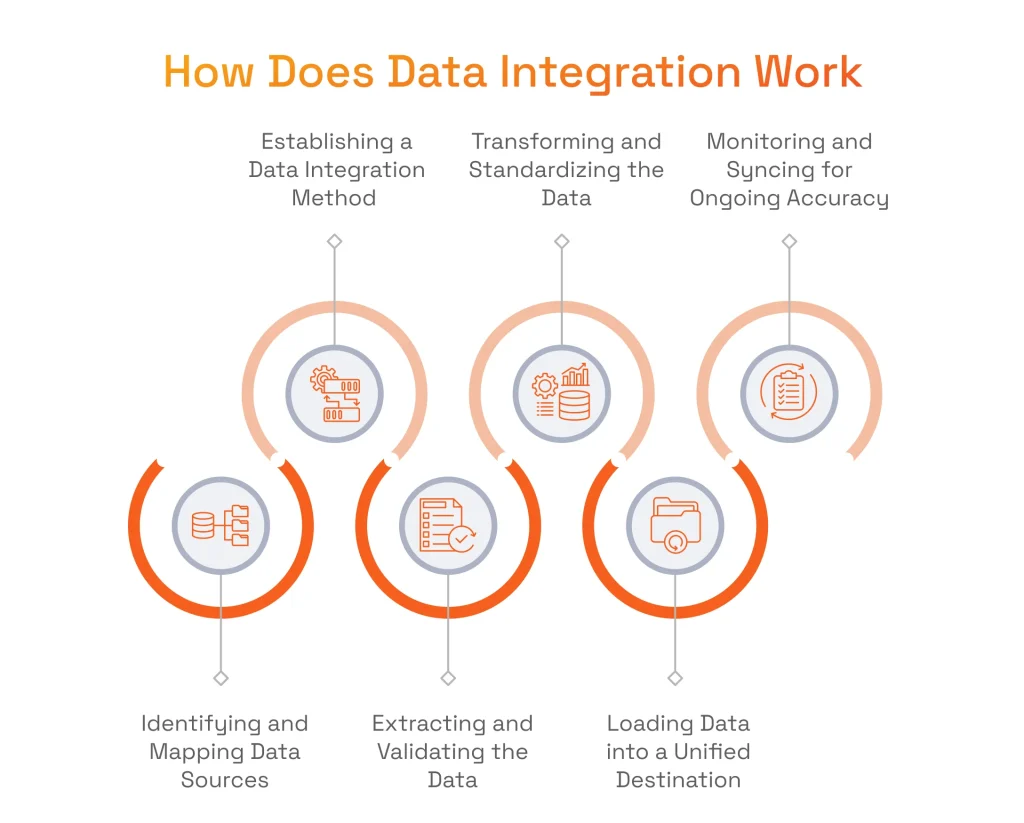
Here’s a simplified overview of the key steps involved that highlights both the technical aspects and their business implications.
Step 1. Identifying and Mapping Data Sources
Before any data can be moved or transformed, you need to get a comprehensive understanding of its origins.
What happens technically? Integration begins with identifying and mapping all relevant internal and external systems: CRMs, ERPs, cloud applications, APIs, databases, analytics platforms, and more. All of this forms the basis for robust data infrastructure and analytics capabilities.
What does it mean for the business? This foundational phase aligns all departments around a shared understanding of critical data sources, effectively breaking down traditional silos and creating a unified inventory of your data assets. It’s vital for integration to align with your enterprise data strategy, ensuring that all data initiatives work toward shared business goals.
Dmytro Tymofiev
Delivery Manager at SPD Technology
When clients ask, ‘how does data integration work,’ I explain it’s about more than just moving data — it’s about creating a unified ecosystem where every piece of information supports smarter and faster business decisions.
Step 2. Establishing a Data Integration Method
Once sources are identified, the next step is to determine the most effective way to move and process the data, depending on your business needs for speed and data freshness.
- ETL (Extract, Transform, Load): Ideal for batch processing, where data is transformed before being loaded into an enterprise data warehouse.
- ELT (Extract, Load, Transform): This approach is often used with cloud data warehouses, where raw data is loaded first and then transformed within the powerful environment of the data warehouse.
- API-based syncing: Provides real-time or near real-time data movement between applications.
- Middleware platforms: These are commonly offered by modern data integration platforms that offer scalable, out-of-the-box connectivity options to facilitate data exchange between diverse systems.
What does it mean for the business? This step defines how fast and how fresh the integrated data will be, which forms the technical backbone of your data integration system. Thus, it enables your business to support real-time dashboards, nightly reports, or hybrid models based on your specific operational needs.
Step 3. Extracting and Validating the Data
Next, we need to carefully extract raw data from its various sources and make sure it fits the purpose.
What happens technically? Raw data is extracted from all identified sources and automatically checked for a variety of potential issues, including missing fields, inconsistent formats, duplicates, and corrupted values.
What does it mean for the business? Rigorous validation ensures that decision-makers are working with accurate and trustworthy information, preventing critical business decisions from being based on partial or flawed inputs.
Step 4. Transforming and Standardizing the Data
Once extracted and validated, data from disparate sources must be transformed into a cohesive, unified format to ensure consistency across the organization.
What happens technically? Data is meticulously restructured to follow a unified schema. This includes normalizing formats (e.g., date formats), standardizing field names (e.g., “CustomerName” vs. “Client_Nm”), converting units, and applying consistent business logic across all datasets.
What does it mean for the business? Such standardization dramatically reduces confusion and enables reliable cross-functional reporting.
Step 5. Loading Data into a Unified Destination
After being processed and transformed, the integrated data is then directed to a centralized location, where it’s readily available for analysis and consumption.
What happens technically? The processed data is loaded into centralized destinations such as:
- A data warehouse (e.g., Snowflake, Google BigQuery, Amazon Redshift) for structured, analytics-ready data.
- A data lake for raw or unstructured data that may be used for future analytics or machine learning.
- Directly into Business Intelligence (BI) dashboards and operational tools for immediate use.
At this point, you need to understand which storage model best suits your business needs: data warehouse vs. data lake. Choosing the right data integration tools is essential at this stage, as they ensure continuous performance monitoring and seamless error handling, which are critical for keeping data pipelines resilient and trustworthy.
Ready to unify your data for powerful analytics and informed decision-making?
Get your ultimate guide to building a data warehouse.
What does it mean for the business? At this stage, integrated data becomes truly accessible, visualized, and ready for decision-making.
Step 6. Monitoring and Syncing for Ongoing Accuracy
Data integration is not a one-time project. It’s a continuous process that requires ongoing monitoring and synchronization to maintain data accuracy and system performance.
What happens technically? Automated pipelines continuously sync new data and monitor for any issues, such as source connection failures, schema mismatches, or data quality anomalies, with automated alerts in place for disruptions.
What does it mean for the business? Confidence in data stability and reliability, with the assurance that systems are operating smoothly and insights remain timely and actionable, forming a continuous loop of data-driven improvement supported by consistent data quality management. Ongoing monitoring not only sustains the health of your system but also enables continuous optimization of your data integration flow.
While the process involves advanced engineering and strategic planning, the ultimate goal of data integration is straightforward: empowering every decision-maker within your organization with reliable, up-to-date, and interconnected data. When integration is done right, businesses cease operating in isolated silos and instead begin to operate with unparalleled clarity and unity.
These six data integration steps form a repeatable framework to ensure reliable data flow across your business and support a sustainable data integration plan.
Need to find the right partner to unlock insights from your complex business data?
Discover how to choose among the best data analytics companies.
Modern Data Integration Examples with the Biggest Impact
Beyond the technical steps, there are the real-world applications of data integration that truly showcase its transformative power. The following examples demonstrate the importance of deep domain knowledge and practical expertise in transforming complex data challenges into strategic advantages across various industries.

- Customer 360 in Fintech, eCommerce, or SaaS: Businesses create a unified view of every customer by integrating data from CRM, sales, marketing automation, customer service, web analytics, and billing systems. This enables hyper-personalized marketing, proactive support, and accurate churn prediction.
- Sales and marketing attribution across CRMs, ads, and support: Combining data from CRM platforms (e.g., Salesforce), advertising platforms (e.g., Google Ads, Meta Ads), and customer support systems allows you to accurately attribute revenue to specific marketing campaigns and optimize spend.
- Operational dashboards that pull from ERP, BI, and product logs: Integrating data from ERP systems, BI tools, and product usage logs creates comprehensive, real-time operational dashboards that provide a holistic view of business performance.
- Real-time fraud detection from unified behavioral signals: In financial services or e-commerce, integrating transactional data with behavioral data, device data, and third-party risk scores in real-time is essential. This enables sophisticated fraud detection systems to identify and flag suspicious activities instantaneously.
- Data-powered product personalization across channels: You integrate customer preferences, past purchase history, browsing behavior, and inventory data across e-commerce platforms, mobile apps, and in-store systems. In such a way, you get highly personalized product recommendations and user experiences, along with boosted engagement and sales.
As for our practical experience, SPD Technology built a centralized platform for managing private investments. This example shows how effective data integration can be. Our tech experts enabled near real-time data unification from providers like Newscatcher, Owler, and S&P by building a scalable data ingestion service and streamlining complex ETL processes.
Critical Signs Your Business Requires Data Integration
Identifying the symptoms of fragmented data within your organization is the crucial first step toward recognizing the urgent need for a more integrated and efficient data ecosystem. These common challenges often signal that your current data architecture is hindering growth and decision-making.
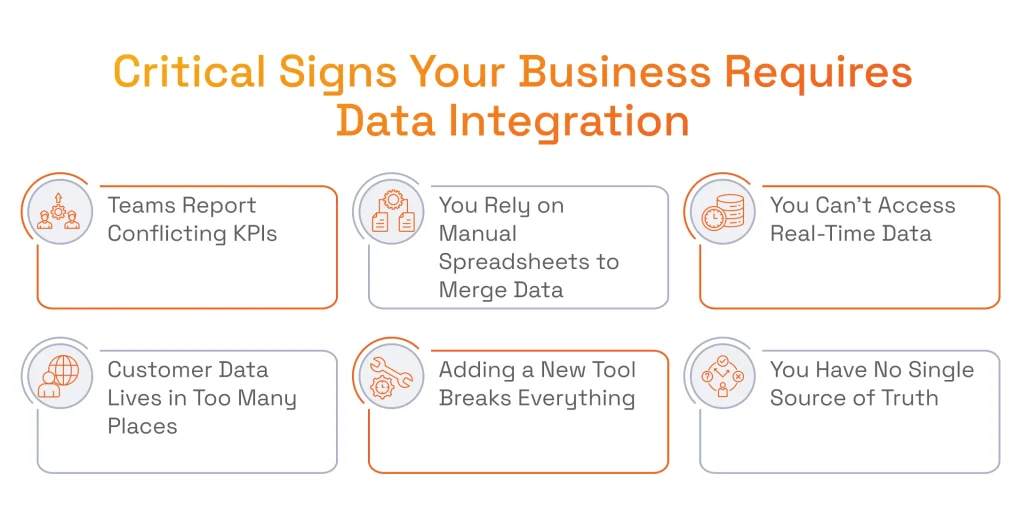
If any of these sound familiar, your business is likely feeling the pain points that data integration can resolve.
- Teams report conflicting KPIs. Your sales team’s revenue numbers don’t match finance’s or marketing’s lead counts, which differ from CRM records.
- You rely on manual spreadsheets to merge data. If your critical reports are built by exporting data to spreadsheets and then manually combining them, you’re wasting time and introducing errors.
- You can’t access real-time data. Decisions are consistently delayed because it takes too long to get current information on sales, inventory, or customer behavior.
- Customer data lives in too many places. Your customer service agents can’t see recent purchases, or your marketing team can’t segment by support history without jumping between multiple applications.
- Adding a new tool breaks everything. Implementing a new system or upgrading an existing one becomes an integration nightmare, which disrupts existing data flows and causes operational headaches.
- You have no single source of truth. There’s no definitive repository for critical business data, leading to constant debate and a lack of confidence in insights.
If some of these signs resonate with your organization, you should know that they are common challenges for businesses. For many companies, addressing these issues begins with taking a closer look at how data flows — or doesn’t flow — across departments and whether the current data architecture can truly support evolving business goals.
At this stage, many teams start to consider the value of data strategy consulting and proficient data integration expertise. This isn’t just about a quick technical fix but about laying a robust foundation for long-term scalability, deeper insights, and seamless cross-functional collaboration. Businesses working with seasoned providers of data analytics services are able to accelerate insights and deliver tangible value faster.
Conclusion
The fragmented data landscape is a silent impediment to innovation, agility, and competitive advantage. Nowadays, the importance of data integration technology cannot be overstated, given the expanding digital transformation and the increasing need for data-driven decision-making.
Pulling in data from every corner of the business gives you more than a complete picture. It gives you control. No more relying on gut feelings or scattered reports. You get clarity.
With that clarity comes confidence. Decisions get sharper. Operations run smoother. From tight financial reporting to ambitious AI projects, it all starts with integration. It’s the foundation on which modern data strategies are built.
Ready to unlock the true potential of your data and move beyond fragmentation? Discover how our data warehousing services can provide the robust foundation your business needs to thrive.
Let’s connect to explore how advanced data integration can bring clarity and confidence to your most critical business decisions.
FAQ
Can small businesses benefit from data integration, or is it only for large enterprises?
Absolutely. Small businesses often feel the pain of inefficiency more acutely than large ones, which makes integration even more valuable. It cuts down on repetitive tasks, brings scattered data together, and helps teams make faster, smarter decisions.
Thanks to cloud-based platforms, it’s also not out of reach financially. You don’t need a full-scale IT department to connect your systems. Thus, small companies stay agile and competitive, even with limited resources.
Is cloud-based data integration different from on-premise?
Cloud-based data integration runs on remote servers, which offers scalability, flexibility, and easier real-time access. On-premise solutions stay within a company’s infrastructure, providing more control but requiring more maintenance and limiting scalability. The on-prem option may suit organizations with strict regulatory or data residency requirements.
Which industries benefit most from data integration?
Any industry juggling data from multiple systems stands to gain. Think healthcare, finance, retail, manufacturing. The sectors live on data: patient records, transactions, inventory, and supply chains. When everything connects, operations get smoother, decisions get faster, and the customer experience improves.
That said, if your business touches more than one data source, data integration isn’t just helpful. It’s essential.


